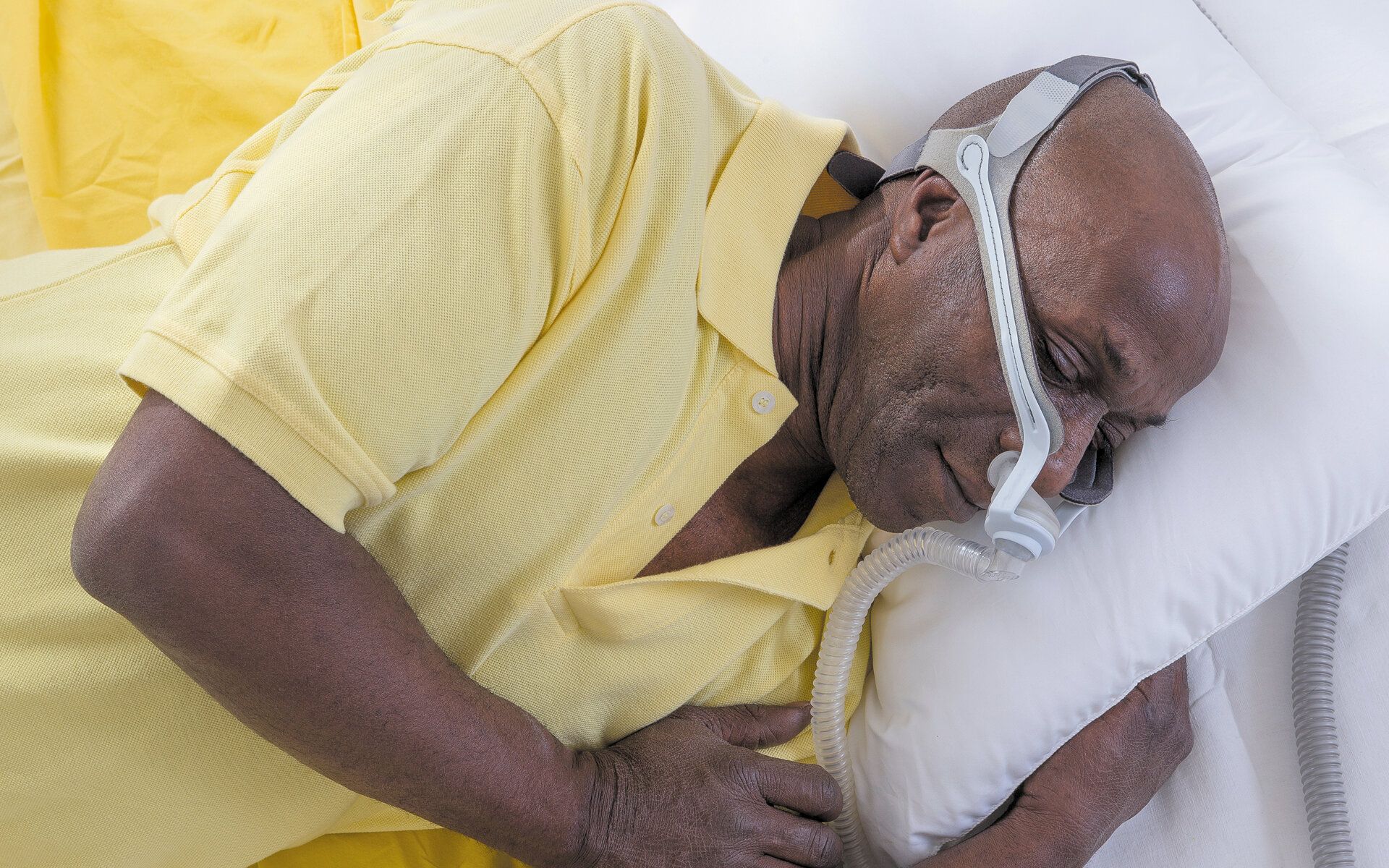Sleep Apnea Syndrome: Symptoms and Treatment

In This Article
-
Apnea is characterized by the cessation of breathing during sleep (apnea attacks) followed by a decrease in the oxygen saturation of the blood; this is followed by waking up, after which breathing is improved.
-
The close relationship between sleep apnea syndrome and cardiovascular diseases has been demonstrated by numerous studies.
“… We have made your sleep for rest.” (78:9)
Sleep is necessary for a healthy life. It is a special blessing to all living things with a metabolism. In normal conditions, the states of being asleep and awake are meant to be in order and rhythm so they align perfectly with our biological operations. However, this rhythm may sometimes be disrupted due to certain disorders, like apnea.
We spend about one third of our lives in sleep. Sleep is an extremely active process that serves for the maintenance of our biological functions and repair of our organs. As our body rests during sleep, it is also relieved of the physical and mental burdens that have accumulated during the day. When this biorhythm between our body clock and sleep is set in order, it becomes one of the major keys for a healthy, happy, and balanced life. Without enough sleep, we cannot fully enjoy our lives; many of our daily activities, including prayers, turn into dry, tasteless practices.
There are two main phases of healthy sleep, "REM" (rapid eye movement) and "non-REM." These phases are repeated four to six times throughout the night, each lasting about 90 minutes. The non-REM phase accounts for 75–80% of sleep and is primarily divided into two periods: the first is the time that includes the transition from wakefulness to sleep and the superficial sleep (the latter accounts for 45–55% of total sleep time). The second period is deep sleep after which we feel most rested [1]. The REM period is the phase in which dreams occur; it begins about 90 minutes after falling asleep. The dreams we remember are from this phase, and it usually constitutes 20–25% of total sleep time. This phase occurs every 90 minutes with a duration of 5–30 minutes each time. During this phase, muscle tension decreases in the whole body, and heartbeats and breathing become irregular [2].
According to the International Classification of Sleep Disorders-2 conducted in 2005, 85 different sleep disorders are grouped under eight main headings [3]. Sleep Apnea Syndrome, which is under the heading of sleep breathing disorders, is frequently encountered, but its prevalence cannot be accurately estimated due to diagnostic insufficiencies. In sleep apnea, breathing is prevented by obstruction of the upper airway during sleep for at least 10 seconds or a little longer and with certain repetitions [4]. Apnea is characterized by the cessation of breathing during sleep (apnea attacks) followed by a decrease in the oxygen saturation of the blood; this is followed by waking up, after which breathing is improved.
Today, the development and diversification in diagnostic methods have brought about more awareness about apnea. Symptoms such as excessive daytime sleepiness, a feeling of suffocation while sleeping, recurrent awakenings during sleep, fatigue, and concentration disorder are quite common in this syndrome.
Snoring occurs as a result of air’s inability to pass easily or the vibration of soft tissues or muscles in the airways. Obstructive sleep apnea is encountered in 35% of patients who snore, while 70-95% of patients with sleep apnea snore.
The increased amount of carbon dioxide in the blood during apnea attacks stimulates the respiratory center, which is located in the back part of our brain. The person is awakened by this reflex, which happens without our consciousness. This is like a form of life insurance, but it interrupts the sleep, thus causing sleep deprivation. This condition is an important symptom, especially in diagnosing patients with severe sleep apnea. In addition to the aforementioned symptoms, forgetfulness, distraction, anxiety, depression, and gastroesophageal reflux can also be encountered.
Sleep apnea can also occur in children. It is relatively more common between the ages of 2-6, and its frequency doubles every 10 years towards adulthood. Although its frequency increases after the age of 60, the severity of clinical findings decreases [5].
Men are at greater risk of apnea due to factors such as the anatomical structures of the pharyngeal areas and airway morphologies (such as fat distribution). There is a proven relationship between obesity and sleep apnea. As you gain weight, the fat cushions on the wall in the pharynx area grow, and the tendency to obstruct this upper airway increases. Sleeping in the supine position can increase the severity of sleep apnea by causing the root of the tongue to block the upper airway. Apnea is more common in relatives of individuals suffering from sleep apnea. It may also occur in connection with some diseases from birth (Trisomy 21, Marfan Syndrome), and it is frequently encountered in African Americans and Asians [6]. All of this suggests a genetic tendency that may lead to the occurrence of apnea.
When sleep apnea is severe, the risk of problems (including death) that may develop due to the disease increases. Death can happen as a result of rhythm disturbances in the heart, changes in pulmonary blood pressure, decreases in oxygen levels after apnea, and sudden damage to the heart and brain due to hypertension, especially in the REM period when dreams occur during sleep. Increased traffic and work accidents due to exhaustion are also among the potential consequences.
The gold standard method used in diagnosis is polysomnography. This can identify type and severity of apnea.
Treatment
So far, there is no accepted drug treatment for sleep apnea. Continuous positive airway pressure (CPAP) and surgical intervention are among the alternative and popular treatments. Even with weight loss alone, sleep quality improves. It is stated that position-dependent apnea syndromes are improved, and oxygen depletion prevented, by not sleeping in the supine position and encouraging side-lying sleep. This may help reduce sleep breathing interruptions due to apnea.
Continuous positive air pressure prevents upper airway obstruction. With this method, intraday sleepiness in moderate and severe sleep apnea patients is greatly improved.
The close relationship between sleep apnea syndrome and cardiovascular diseases has been demonstrated by numerous studies. The use of CPAP in hypertensive sleep apnea patients contributes to lowering blood pressure values both at night and during the day. Controlling the preventable complications and symptoms associated with the disease can significantly improve quality of life.
The need for consistent sleep varies from person to person. People don't just sleep at night, nor should they. One may also consider Prophetic advice on sleeping habits in relation to time (like Prophet Muhammad’s, peace be upon him, mid-day nap – qailula), human nature, and biological wellbeing.
References
- R. B. Berry ve ark. The AASM Manual for the Scoring of Sleep and Associated Events: Rules, Terminology and Technical Specifications, The American Academy of Sleep Medicine, 2007, s. 17–31.
- H. Schulz, “Phasic or transient? Comment on the terminology of the AASM manual for the scoring of sleep and associated events”, J Clin Sleep Med, 2007, 3, p. 752.
- H. W. Duchna, “Sleep-related breathing disorders: A second edition of the International Classification of Sleep Disorders (ICSD-2) of the American Academy of Sleep Medicine (AASM)”, Pneumologie, 2006, 60, pp. 568–575.
- J. M. Shneerson, Sleep Medicine: A Guide to Sleep and Its Disorders, New Jersey: Wiley-Blackwell, 2005, pp. 229–262.
- Ibid.
- Schulz.









